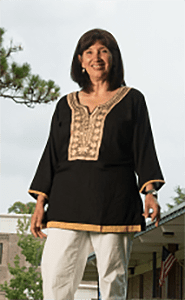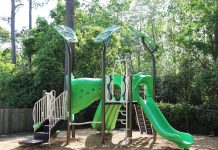 UWF Profesor Realiza Evaluaciones de la Salud Bucal en Ecuador
UWF Profesor Realiza Evaluaciones de la Salud Bucal en Ecuador
By Brandy Allport, uwf.edu/creo
Pensacola – Dr. Denice Curtis, profesor asistente en el Departamento de Salud Pública de la Universidad de West Florida, ha estado haciendo su parte para difundir la información sobre la buena salud dental. A través de un acuerdo con el UWF y la Universidad de San Francisco de Quito, en Ecuador, ayudó a llevar a cabo una evaluación del estado de la salud oral en tres comunidades de Ecuador este verano.
La caries dental es la enfermedad crónica infantil más común. Es cinco veces más común que el asma y siete veces más común que la fiebre del heno, según los Centros para el Control y la Prevención de Enfermedades. En los EE.UU., se hace mucho para ofrecer educación y buenos controles de salud bucal para ayudar a prevenir esta enfermedad. Sin embargo, esto no siempre es el caso en otros países.
Con la ayuda de los higienistas, odontólogos y estudiantes de odontología asociados con la Universidad de San Francisco de Quito, la Universidad Central de Quito y Colegio Politécnico de Chimborazo, Curtis administro 170 encuestas realizadas a los adultos y unos 150 exámenes clínicos básicos a niños de 6-12 años de edad.
Curtis escribió una propuesta denominada “Evaluación del estado de salud oral en tres comunidades indígenas” en Ecuador y recibió financiación a través de una subvención de la actividad académica y creativa de la Oficina de Investigación y Programas Patrocinados con el UWF para completar su trabajo en el viaje. Los objetivos del estudio fueron:
Evaluar las comunidades de salud bucodental conocimientos, actitudes y comportamientos relacionados con la salud oral.
- Determinar el factor de riesgo de caries entre los niños.
- Medir las concentraciones de fluoruro en el agua siguientes directrices de los CDC para la prueba.
- Fomentar la colaboración y las asociaciones entre las comunidades y las entidades que participan en el estudio para promover la sostenibilidad .
- Explorar más colaboración con la Universidad de la escuela San Francisco de Quito de la odontología para los estudios de seguimiento y actividades educativas .
En las clínicas en las pequeñas poblaciones rurales de Salasaca y Guangaje en los Andes y en la vecindad de Itulcachi cerca de Quito, la capital, los niños fueron tratados a un examen oral básica, y los adultos se les dio información sobre el cuidado y la higiene. Debido a que la fluorosis es un problema de salud que afecta a estas comunidades, las fuentes de agua locales se pusieron a prueba para el exceso de fluoruro.
Los niños llegaron con sus viejos cepillos de dientes, que se intercambian por otros nuevos, y se les dio un tubo de pasta de dientes.
“Es más barato prevenir que se trata de tratar”, dijo Curtis. “Lo que queremos es promover estrategias de prevención a través de la higiene bucal. Queremos crear conciencia sobre la manera de abordar los factores de riesgo para la enfermedad oral con el fin de prevenir la caries dental y las enfermedades orales “.
Para los padres de todo el mundo que quieren establecer una buena salud dental de sus hijos, las siguientes directrices generales de healthychildren.org pueden ayudar.
Fluoruro y su hijo: El fluoruro es un mineral natural que se encuentra en muchos alimentos, y también se añade al agua potable en algunas ciudades y pueblos. Puede beneficiar a la salud dental mediante el fortalecimiento del esmalte de los dientes, por lo que es más resistente a los ataques ácidos que pueden causar caries en los dientes. También reduce la capacidad de las bacterias de la placa para producir ácido. Consulte con su agencia sanitaria local para averiguar si el agua tiene fluoruro. Si no es así, consulte a su médico si debe obtener una receta para gotas de fluoruro o tabletas masticables para su hijo.
Revisar y limpiar los dientes de su bebé: Los dientes saludables tienen un color uniforme. Si ve manchas en los dientes, lleve a su bebé al dentista. Tan pronto como su hijo tiene un diente, empiece a usar un frotis, aproximadamente del tamaño de un grano de arroz, de pasta dental con fluoruro. Limpie sus dientes al menos dos veces al día. Es mejor limpiarlos justo después del desayuno y antes de acostarse. Cuando su niño cumpla 3 años, se puede empezar a usar una cantidad pequeña de pasta dental con fluoruro. Cuando su hijo es capaz, enséñele a escupir el exceso de pasta, pero no enjuague con agua. A medida que su hijo crezca, deje que use su propio cepillo de dientes. Es mejor que le ponga la pasta de dientes en el cepillo de dientes hasta que su hijo tenga aproximadamente 6 años de edad, hasta que sus niños tengan 7 u 8 años de edad, tendrá que ayudarles a cepillar sus dientes. Trate de cepillarles los dientes y dejar que terminen solos.
Alimente a su bebé con alimentos saludables: Elija bebidas y alimentos que no tienen una gran cantidad de azúcar en ellos. Dele a su hijo frutas y verduras en lugar de dulces y galletas. Tenga cuidado con las frutas secas, como pasas, ya que se adhieren fácilmente a las ranuras de los dientes y pueden causar caries si no es cepillado a fondo de los dientes.
Prevenir la caries dental: No ponga a su bebé en la cama con una botella en la noche o durante la siesta. (Si acuesta a su bebé con un biberón, llénelo con agua solamente). La leche, fórmula, jugos y otras bebidas dulces, como refrescos, todos tienen azúcar en ellos. Chupar un biberón lleno de líquidos que contienen azúcar pueden causar caries en los dientes. Durante el día, no le dé a su bebé un biberón lleno de bebidas azucarados como si fuera un chupete. Si su bebé usa un chupete, no lo sumerja en nada dulce como el azúcar o la miel. Cerca de su primer año de vida, se debe enseñar a su niño a beber de una taza en lugar de una botella.
Hable con su pediatra sobre la fabricación de un hogar dental: Debido a que su pediatra verá a su bebé a partir de los primeros días y semanas de vida, planificar para discutir cuándo y cómo se debe desarrollar posteriormente un “hogar dental” – un dentista que puede dar consistente, de alta calidad, la atención profesional – al igual que usted tiene un “hogar médico” con su pediatra. Por lo general, el dentista tendrá que ver a un niño por su primer cumpleaños o dentro de los seis meses de la aparición del primer diente. En la primera visita, el dentista puede comprobar fácilmente los dientes de su hijo y determinar la frecuencia de los chequeos dentales en el futuro.
 UWF Professor Conducts Oral Health Assessments in Ecuador
UWF Professor Conducts Oral Health Assessments in Ecuador
By Brandy Allport, uwf.edu/creo
Pensacola – Dr. Denice Curtis, an assistant professor in the Department of Public Health at the University of West Florida, has been doing her part to spread the word about good dental health. Through an agreement with UWF and the University of San Francisco de Quito in Ecuador, she helped conduct an assessment of the status of oral health in three Ecuadorean communities this summer.
Tooth decay is the most common chronic children’s disease. It’s five times more common than asthma and seven times more common than hay fever, according to the Centers for Disease Control and Prevention. In the U.S., much is done to provide education and good oral health screenings to help prevent this malady. But, this is not always the case in other countries.
With the help of hygienists, dentists and dental students associated with the University of San Francisco de Quito, the Central University in Quito and Polytechnical College of Chimborazo, Curtis administered 170 surveys to adults and performed about 150 basic clinical exams on children ages 6-12.
Curtis wrote a proposal called “Assessing the oral health status in three indigenous communities” in Ecuador and received funding through a scholarly and creative activity grant from the Office of Research and Sponsored Programsat UWF to complete her work on the trip. The objectives of the study were:
- Assess the communities’ oral health knowledge, attitudes and behaviors regarding oral health.
- Determine risk factor for caries among children.
- Measure fluoride concentrations in the water following CDC guidelines for testing.
- Foster collaboration and partnerships between the communities and the entities involved in the study to promote sustainability.
- Explore further collaboration with the University of San Francisco de Quito school of dentistry for follow-up studies and educational activities.
At the clinics in the small rural towns of Salasaca and Guangaje in the Andes and in the neighborhood of Itulcachi near Quito, the capital, children were treated to a basic oral exam, and adults were given information about proper care and hygiene. Because fluorosis is a health issue that affects these communities, the local water sources were tested for excess fluoride.
The children came with their old toothbrushes, which they exchanged for new ones, and were given a tube of toothpaste.
“It’s cheaper to prevent than it is to treat,” Curtis said. “What we want is to promote prevention strategies through oral hygiene. We want to create awareness on how to address the risk factors for oral disease in order to prevent tooth decay and oral diseases.”
For parents everywhere who want to establish good dental health for their children, the following general guidelines from healthychildren.org can help.
Fluoride and your child: Fluoride is a naturally occurring mineral that is found in many foods, and it also is added to the drinking water in some cities and towns. It can benefit dental health by strengthening the tooth enamel, making it more resistant to acid attacks that can cause tooth decay. It also reduces the ability of plaque bacteria to produce acid. Check with your local water utility agency to find out if your water has fluoride in it. If it doesn’t, ask your doctor if you should get a prescription for fluoride drops or chewable tablets for your child.
Check and clean your baby’s teeth: Healthy teeth should be all one color. If you see spots or stains on the teeth, take your baby to your dentist. As soon as your child has a tooth, begin to use a smear, about the size of a grain of rice, of fluoride toothpaste. Clean the teeth at least twice a day. It’s best to clean them right after breakfast and before bedtime. When your child turns 3, you can begin to use a pea-sized amount of fluoride toothpaste. When your child is able, teach him to spit out the excess toothpaste, but don’t rinse with water. As your child gets older, let her use her own toothbrush. It is best if you put the toothpaste on the toothbrush until your child is about age 6. Until children are 7 or 8 years old, you will need to help them brush. Try brushing their teeth first and then letting them finish.
Feed your baby healthy food: Choose drinks and foods that do not have a lot of sugar in them. Give your child fruits and vegetables instead of candy and cookies. Be careful with dried fruits, such as raisins, since they easily stick to the grooves of the teeth and can cause cavities if not thoroughly brushed off the teeth.
Prevent tooth decay: Do not put your baby to bed with a bottle at night or at naptime. (If you do put your baby to bed with a bottle, fill it only with water). Milk, formula, juices and other sweet drinks, such as soda, all have sugar in them. Sucking on a bottle filled with liquids that have sugar in them can cause tooth decay. During the day, do not give your baby a bottle filled with sweet drinks to use like a pacifier. If your baby uses a pacifier, do not dip it in anything sweet like sugar or honey. Near his first birthday, you should teach your child to drink from a cup instead of a bottle. Do not pass eating utensils from your mouth to the baby’s.
Talk with your pediatrician about making a dental home: Because your pediatrician will be seeing your baby from the first days and weeks of life, plan to discuss when and how you should later develop a “dental home” – a dentist who can give consistent, high-quality, professional care – just as you have a “medical home” with your pediatrician. Usually, your dentist will want to see a child by his first birthday or within six months of the first tooth’s emergence. At this first visit, your dentist can easily check your child’s teeth and determine the frequency of future dental checkups.

















